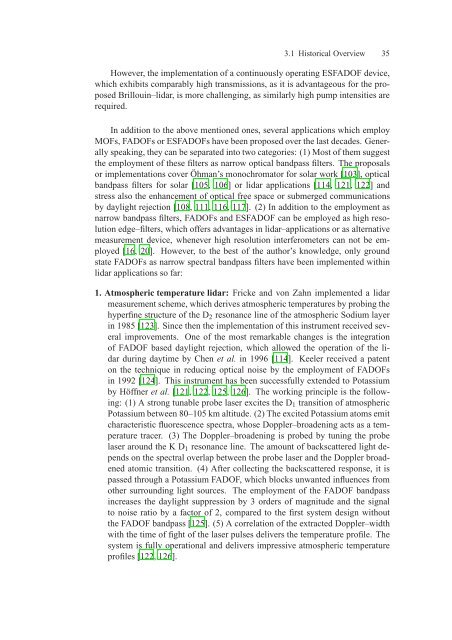Assessment of a Rubidium ESFADOF Edge-Filter as ... - tuprints
Assessment of a Rubidium ESFADOF Edge-Filter as ... - tuprints
Assessment of a Rubidium ESFADOF Edge-Filter as ... - tuprints
Create successful ePaper yourself
Turn your PDF publications into a flip-book with our unique Google optimized e-Paper software.
3.1 Historical Overview 35<br />
However, the implementation <strong>of</strong> a continuously operating <strong>ESFADOF</strong> device,<br />
which exhibits comparably high transmissions, <strong>as</strong> it is advantageous for the proposed<br />
Brillouin–lidar, is more challenging, <strong>as</strong> similarly high pump intensities are<br />
required.<br />
In addition to the above mentioned ones, several applications which employ<br />
MOFs, FADOFs or <strong>ESFADOF</strong>s have been proposed over the l<strong>as</strong>t decades. Generally<br />
speaking, they can be separated into two categories: (1) Most <strong>of</strong> them suggest<br />
the employment <strong>of</strong> these filters <strong>as</strong> narrow optical bandp<strong>as</strong>s filters. The proposals<br />
or implementations cover Öhman’s monochromator for solar work [103], optical<br />
bandp<strong>as</strong>s filters for solar [105, 106] or lidar applications [114, 121, 122] and<br />
stress also the enhancement <strong>of</strong> optical free space or submerged communications<br />
by daylight rejection [108, 111, 116, 117]. (2) In addition to the employment <strong>as</strong><br />
narrow bandp<strong>as</strong>s filters, FADOFs and <strong>ESFADOF</strong> can be employed <strong>as</strong> high resolution<br />
edge–filters, which <strong>of</strong>fers advantages in lidar–applications or <strong>as</strong> alternative<br />
me<strong>as</strong>urement device, whenever high resolution interferometers can not be employed<br />
[16, 20]. However, to the best <strong>of</strong> the author’s knowledge, only ground<br />
state FADOFs <strong>as</strong> narrow spectral bandp<strong>as</strong>s filters have been implemented within<br />
lidar applications so far:<br />
1. Atmospheric temperature lidar: Fricke and von Zahn implemented a lidar<br />
me<strong>as</strong>urement scheme, which derives atmospheric temperatures by probing the<br />
hyperfine structure <strong>of</strong> the D 2 resonance line <strong>of</strong> the atmospheric Sodium layer<br />
in 1985 [123]. Since then the implementation <strong>of</strong> this instrument received several<br />
improvements. One <strong>of</strong> the most remarkable changes is the integration<br />
<strong>of</strong> FADOF b<strong>as</strong>ed daylight rejection, which allowed the operation <strong>of</strong> the lidar<br />
during daytime by Chen et al. in 1996 [114]. Keeler received a patent<br />
on the technique in reducing optical noise by the employment <strong>of</strong> FADOFs<br />
in 1992 [124]. This instrument h<strong>as</strong> been successfully extended to Pot<strong>as</strong>sium<br />
by Höffner et al. [121, 122, 125, 126]. The working principle is the following:<br />
(1) A strong tunable probe l<strong>as</strong>er excites the D 1 transition <strong>of</strong> atmospheric<br />
Pot<strong>as</strong>sium between 80–105 km altitude. (2) The excited Pot<strong>as</strong>sium atoms emit<br />
characteristic fluorescence spectra, whose Doppler–broadening acts <strong>as</strong> a temperature<br />
tracer. (3) The Doppler–broadening is probed by tuning the probe<br />
l<strong>as</strong>er around the K D 1 resonance line. The amount <strong>of</strong> backscattered light depends<br />
on the spectral overlap between the probe l<strong>as</strong>er and the Doppler broadened<br />
atomic transition. (4) After collecting the backscattered response, it is<br />
p<strong>as</strong>sed through a Pot<strong>as</strong>sium FADOF, which blocks unwanted influences from<br />
other surrounding light sources. The employment <strong>of</strong> the FADOF bandp<strong>as</strong>s<br />
incre<strong>as</strong>es the daylight suppression by 3 orders <strong>of</strong> magnitude and the signal<br />
to noise ratio by a factor <strong>of</strong> 2, compared to the first system design without<br />
the FADOF bandp<strong>as</strong>s [125]. (5) A correlation <strong>of</strong> the extracted Doppler–width<br />
with the time <strong>of</strong> fight <strong>of</strong> the l<strong>as</strong>er pulses delivers the temperature pr<strong>of</strong>ile. The<br />
system is fully operational and delivers impressive atmospheric temperature<br />
pr<strong>of</strong>iles [122, 126].
















